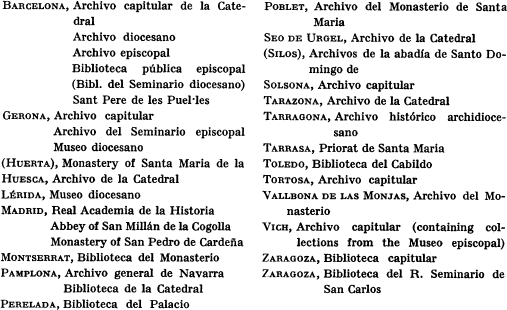Article contents
Medieval Liturgical Books in Twenty-Three Spanish Libraries: Provisional Inventories
Published online by Cambridge University Press: 29 July 2016
Extract
(Barcelona, El Escorial, Gerona, Huesca, Lérida, Madrid, Montserrat, Pamplona, Poblet, Seo de Urgel, Silos, Tarazona, Toledo, Tortosa, Vallbona de las Monjas, Vich)
This article is mainly concerned with Office Books, but does not include books for the Mozarabic rite. A few books for the Mass etc. were included as a result of earlier incorrect descriptions; these were inspected and eliminated without further investigation.
- Type
- Bibliographical Study
- Information
- Copyright
- Copyright © Fordham University Press
References
1 The most useful recent catalogue of musical sources is that of Fernández de la Cuesta, I., Manuscritos y fuentes musicales en España: Edad Media (Madrid 1980). This book lists only the musical manuscripts, but includes more libraries than does this article. Most of the entries are very brief. Descriptive titles are not sufficiently accurate (Psalter and Hymnals, for example, are referred to as Breviaries without qualification). There are, however, extremely useful indices of feasts, incipits, and other matters.Google Scholar
2 ‘Medieval Liturgical Books at Arouca, Braga, Évora, Lisbon, and Porto: Some Provisional Inventories,’ Traditio 31 (1975) 369–84.Google Scholar
3 I discuss the problems briefly in my book Medieval Manuscripts for Mass and Office: A Guide to Their Organization and Terminology (Toronto 1982). Clear, widely-accepted, and consistent guidelines for the description of manuscripts (akin to those of the Library of Congress for printed books) could and should be adopted after discussion by scholars in the field. The present Library of Congress methods are of little use for manuscripts. I propose to broach the subject in another article.Google Scholar
4 I should like to thank the Hill Monastic Manuscript Library (= HMML) for a generous travel grant which enabled me to visit the library, and Dr. Julian G. Plante and his staff, especially Peter Jeffery, for their hospitality and assistance during my stay. The latter's publications, A Bibliography for Medieval and Renaissance Musical Manuscript Research (Collegeville 1980) and ‘Music Manuscripts on Microfilm in the Hill Monastic Manuscript Library at St. John's Abbey and University,’ Notes 35 (1978–79) 7–30, describe the musical holdings of the library in general.CrossRefGoogle Scholar
5 Plante, J. G., Checklist of Manuscripts Microfilmed for the Hill Monastic Manuscript Library: II. Spain (part 1) (Collegeville 1978). Catalogues for the Spanish libraries are listed in this Checklist and in the regular progress reports issued by HMML. They may also be found listed in Kristeller, P. O., Latin Manuscript Books before 1600 (3rd ed.; New York 1965) and Benton, R., Directory of Music Research Libraries III (Iowa City 1973). There are lists of manuscripts in Donovan, R. B., The Liturgical Drama in Medieval Spain (Toronto 1958) 200–16, but these are mostly culled from earlier publications and preserve their errors.Google Scholar
6 These are sigla based on my own personal system. The logic behind the system should be readily apparent.Google Scholar
7
As of the summer of 1981, HMML has films of manuscripts (sometimes only some of the manuscripts) from the following libraries:  Google Scholar
Google Scholar
The Progress Report: VIII. Spain … (1974–1980) published by HMML (ed. J. G. Plante; Collegeville 1980), gives more details regarding the libraries and their affiliations; the Checklist mentioned in note 4 gives more details concerning the manuscripts. Of the manuscripts which appeared from the descriptions to be relevant, I inspected about 90%, including all those likely to include chant. Books bearing descriptions such as the following were investigated: Antiphonal, Breviary, Liber liturgicus, Liber de choro, Officia, Sanctorale, Cantica sacra.
8 Cf. Fernández (supra n. 1).Google Scholar
9 AH vols. 5, 13, 14b, 17, 18, 24 (ed. G. M. Dreves), 25 (ed. Blume), 26, 28, 45a (edd. Blume and Dreves), 52 (ed. Blume): Volume 17 is devoted to Spain. See my Medieval Music: The Sixth Liberal Art (rev. ed.; Toronto 1980) item 56a.Google Scholar
10 Analecta Hymnica: Register (ed. M. Lütolf; 2 vols. in 3; Bern 1978).Google Scholar
11 Investigation of the rhymed office has been my principal research topic for more than a decade. I am now only on the verge of assessing the voluminous evidence to the extent that I can say more than elementary things about the repertory.Google Scholar
12 Cabrol, F., ‘Le culte de la Trinité dans la liturgie …,’ Ephemerides Liturgicae 45 (1931) 270–78.Google Scholar
13 Cf. op. cit. (supra n. 2) and other books on chant for descriptions of this musical term.Google Scholar
14 I have encountered this arrangement elsewhere, but I cannot easily find the reference: it is buried on one of several thousand cards on liturgical manuscripts, few of which are comprehensively cross-referenced. It may be of interest to know that this article (and most of what I do now) is in machine-readable form, on North Star 5-inch discs prepared on a personal micro-computer with a word-processor under CP/M. Eventually, I hope to transfer all the cards into this form, where they can be much more easily cross-referenced.Google Scholar
15 Cf. op. cit. (supra n. 2).Google Scholar
- 2
- Cited by




